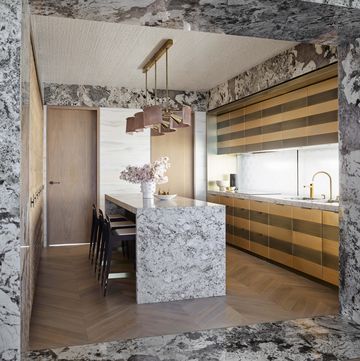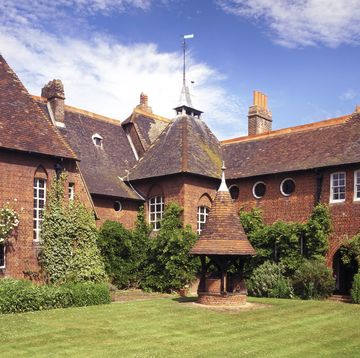Renowned British architect Zaha Hadid famously said during an interview in 2003: ‘Would you still call me a diva if I were a man?’ It’s hardly news that women face disadvantages in the workplace, and the construction industry has been particularly culpable. In the 20th century, women were routinely refused entry to architecture schools, and today they occupy just ten per cent of the highest-ranking jobs.
Breaking Ground: Architecture by Women (£29.95, Phaidon) marks and celebrates women’s roles in the architectural world, and presents a glorious visual manifesto of more than 180 exceptional buildings from around the world. In an extract from the book, author Jane Hall profiles the top female architects born or based in Britain, all working at a time when determination, boundary-pushing and breaking the mould has had to be at the very forefront of their practice.
FARSHID MOUSSAVI
British architect Moussavi was born in Iran and co-founded Foreign Office Architects with Alejandro Zaera-Polo in 1993, working on a mixture of projects including the futuristic Yokohama Ferry Terminal in Japan. Moussavi went on to establish Farshid Moussavi Architecture (FMA) in 2011. The studio’s projects include the Museum of Contemporary Art in Cleveland, United States(above, 2012), clad in mirrored black stainless steel. Moussavi’s work is rooted in critical research, which she carries out throughFunctionLab, the research branch of FMA. farshidmoussavi.com
What's everyone reading?
ALISON BROOKS
Brooks is an internationally revered UK-based architect, best known for her work in housing, regeneration and education. Herstudio has created a variety of works, from The Smile (below), a banana-shaped pavilion for the 2016 London Design Festival, to acampus for Exeter College at the University of Oxford (2017). She is the only British architect to have won all three of the UK’smost prestigious architecture awards: the Stirling Prize, the Manser Medal, and the Stephen Lawrence Prize. In 2013, she receivedthe Architect of the Year prize at the Women in Architecture awards. alisonbrooksarchitects.com
STEPHANIE MACDONALD
Macdonald established 6a Architects with Tom Emerson in 2001. She has since developed the practice’s collaborative approach, working with consultants, artists, designers and scientists among others. The studio is best known for its art galleries, educational buildings, artists’ studios and residential projects, often in sensitive historic environments. A new building for the MK Gallery in Milton Keynes has been described as being poised ‘between high technology and low-rise suburbia’. Cowan Court (above, 2016) at the University of Cambridge’s Churchill College uses oak cladding that echoes the materiality of the original college. It won a Royal Institute of British Architects East Award in 2017. 6a.co.uk
SU ROGERS
Su Rogers is an architect and academic who has played a leading role in post-war architectural design. She has been a partner in numerous practices including Team 4 (1963–7); Richard + Su Rogers Architects (1967–70); and Colquhoun, Miller and Partners, later John Miller + Partners (1986–2011). Rogers contributed to the competition-winning design of thePompidou Centre (1977) in Paris, and is responsible for the concept for ‘Zip-Up House’ (1969). Her residential projects, Creek Vean and Pillwood House (above) – both in Feock, Cornwall– are heritage-listed and are important works of 20th-century British architecture.
KATHRYN FINDLAY
The late Scottish-born architect Findlay (1953–2014) made her name as an avant-garde modernist architect in Japan when she moved to Tokyo in 1979, after graduating from theArchitectural Association School in London. There, she established Ushida Findlay Architects with Eisaku Ushida. The duo created brilliantly original projects, such as the Soft and Hairy House (1994) and the Truss Wall House (above, 1993), both in Tokyo. Findlay moved back to the UK in 1999, and collaborated with Anish Kapoor on the Arcelor Mittal Orbit tower in the Queen Elizabeth Olympic Park, London (2012).
SARAH WIGGLESWORTH
Wigglesworth is widely acknowledged as a pioneering influence in British architecture and is particularly known for her experience in sustainable design. Her approach is epitomised in projects such as the Stock Orchard Street house in London (2001) and the Bermondsey Bicycle Store (above, 2008), aiming to embed green transport values within the community. Until 2016, she was professor of architecture at the University of Sheffield, where she led research into the design of exemplary neighbourhoods for older people. swarch.co.uk
CHARLOTTE SKENE CATLING
Skene Catling co-founded Skene Catling de la Peña, where she is an architect and director, with Jaime de la Peña in London in2003. The practice is known for integrating contemporary projects into heritage-listed buildings, such as the Perm-36 WorldHeritage Site in Russia (2010) – their Flint House (below) won the Royal Institute of British Architects House of the Year award in 2015. Skene Catling now teaches at the Karlsruhe Institute of Technology in Germany. scdlp.net
Breaking Ground: Architecture by Women by Jane Hall is out now (£29.95, Phaidon)
This article first appeared in ELLE Decoration October 2019
Like this article? Sign up to our newsletter to get more articles like this delivered straight to your inbox.


















